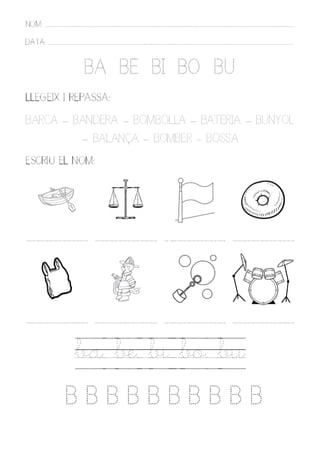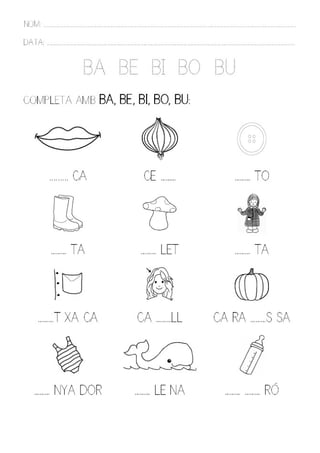D b
Download as doc, pdf0 likes924 views
FITXES PER TREBALLAR LES LLETRES B I D A NIVELL DE P5 O CICLE INICIAL ES PODEN DESCARREGAR A LA WEB: https://sites.google.com/site/activitatsperprimerdeprimaria/llengua-catalana/lectoescriptura
1 of 4
Downloaded 41 times




Ad
Recommended
M├Āquines de calcular
M├Āquines de calcularMonica Roige Sedo
╠²
es pot descarregar m├®s material a la web:
https://sites.google.com/site/activitatsperprimerdeprimaria/matemat/numeracio-i-calculNumeraci├│ i c├Ālcul.1
Numeraci├│ i c├Ālcul.1Monica Roige Sedo
╠²
MATERIAL PER IMPRIMIR PENSAT PER CICLE INICIAL DE PRIM├ĆRIA
Hi ha m├®s material a la web: https://sites.google.com/site/activitatsperprimerdeprimaria/matematRelacions,canvi, equival├©ncies
Relacions,canvi, equival├©nciesMonica Roige Sedo
╠²
2 fitxes per imprimir per davant i per darrere per treballar relacions, canvi i equival├©ncies de mesures
m├®s material a la web: https://sites.google.com/site/activitatsperprimerdeprimaria/matemat/relacions-i-canvila descripci├│ a cicle inicial
la descripci├│ a cicle inicialMonica Roige Sedo
╠²
Fitxes per treballar la descripci├│ a nivell de cicle inicial de prim├Āria.
Es poden descarregar a la web:
https://sites.google.com/site/activitatsperprimerdeprimaria/llengua-catalana/lectoescripturaSonido z, k y g suaveMonica Roige Sedo
╠²
El documento menciona varias palabras sueltas relacionadas con la escuela, el circo, personas y lugares como Miguel, peque├▒o, zombies, esqueletos, cafeter├Ła, esquina y plaza, as├Ł como zumo de cereza. Tambi├®n incluye las palabras cuando, casa, Celia, guapa, quiso, gusano, tropez├│, hizo y esguince.Multiplicacions,pensa i comprova
Multiplicacions,pensa i comprovaMonica Roige Sedo
╠²
This document contains a series of multiplication problems with the answers provided to check the results. It includes 20 multiplication problems ranging from 2 x 0 to 5 x 8, with the numbers multiplied getting larger throughout. The purpose is to practice multiplication skills and verify the calculated answers.m.c.m. i m.c.d.
m.c.m. i m.c.d.Monica Roige Sedo
╠²
The document discusses the minimum common multiple (MCM) and maximum common divisor (MCD) of two numbers. It provides examples of finding the MCM of 4 and 5, which is 20, and the MCD of 24 and 30, which is 6. To find the MCM, it lists the multiples of the two numbers and finds the smallest number that is a multiple of both. To find the MCD, it lists the divisors of the two numbers and finds the largest number that divides both.Projeccions amb policubs
Projeccions amb policubsMonica Roige Sedo
╠²
Exercicis per construir figures amb multicubs a partir de les seves projeccionsEndevinalles
EndevinallesMonica Roige Sedo
╠²
Comprensi├│ lectora, endevinalles, educaci├│ prim├Āria, cicle inicial, cicle mitj├Ā, cicle superior, llengua catalana, Les vil┬Ęles romanes
Les vil┬Ęles romanesMonica Roige Sedo
╠²
The Roman cities were organized according to a grid plan with two main streets intersecting at the center, where there was a forum for political and commercial life. Cardo and decumanus were the names of the two main streets crossing each other at right angles. Public buildings such as temples, basilicas, baths, and theaters were located near the forum at the intersection of the cardo and decumanus.Les ciutats romanes
Les ciutats romanesMonica Roige Sedo
╠²
The document discusses Roman cities and their urban planning. Roman cities had a standardized layout with main roads intersecting to form city blocks. Public spaces and buildings such as forums, temples, baths, and amphitheaters were located near the center of towns for all citizens to access. Roman urban design principles focused on functionality, order, and civic amenities which influenced city planning for centuries.En ├©poca dels romans
En ├©poca dels romansMonica Roige Sedo
╠²
El document tracta sobre els pobles preromans durant l'├©poca romana, incloent els celtes, ibers i cartaginesos. Aporta informaci├│ sobre la seva cultura i organitzaci├│ social. Tamb├® es menciona la conquesta romana d'aquests pobles.SimetriaMonica Roige Sedo
╠²
Este documento trata sobre la simetr├Ła en figuras geom├®tricas. Explica que una figura es sim├®trica si tiene uno o m├Īs ejes de simetr├Ła, y que al tener una figura y un eje podemos crear otra figura sim├®trica respecto a ese eje. Pregunta cu├Īles figuras tienen bien dibujado su eje de simetr├Ła y cu├Īntos ejes de simetr├Ła tienen algunos pol├Łgonos.Ortografia. s├Łl┬Ęlaba.accent gr├Āfic.diftongs.hiats.d├Łgrafs
Ortografia. s├Łl┬Ęlaba.accent gr├Āfic.diftongs.hiats.d├ŁgrafsMonica Roige Sedo
╠²
Ortografia: s├Łl┬Ęlaba, separar per s├Łl┬Ęlabes i accentuaci├│.LECTURA DE PARAULES AMB LES LLETRES: Pmlcbt
LECTURA DE PARAULES AMB LES LLETRES: PmlcbtMonica Roige Sedo
╠²
This document contains a list of Spanish words in no particular order. Some of the words are common nouns like "casa" (house) and "mesa" (table). Others are verbs like "bebe" (drinks) or objects like "pelota" (ball). The list seems to include over 50 different words from across the Spanish language without any grouping or organization.LECTURA DE PARAULES AMB LES LLETRES:Pmlcbtndsr
LECTURA DE PARAULES AMB LES LLETRES:PmlcbtndsrMonica Roige Sedo
╠²
This document contains a list of Spanish words in no particular order. There is no other context or information provided about the meaning or usage of these words. The list includes common nouns from various semantic categories as well as verbs and other parts of speech.LECTURA DE PARAULES AMB LES LLETRES:Pmlcbtndsrquhf
LECTURA DE PARAULES AMB LES LLETRES:PmlcbtndsrquhfMonica Roige Sedo
╠²
This document contains a list of Spanish words in no particular order. There are over 100 words from different categories including objects, animals, family members, foods, activities, and more. The words range from common terms to more obscure vocabulary.More Related Content
More from Monica Roige Sedo (20)
Sonido z, k y g suaveMonica Roige Sedo
╠²
El documento menciona varias palabras sueltas relacionadas con la escuela, el circo, personas y lugares como Miguel, peque├▒o, zombies, esqueletos, cafeter├Ła, esquina y plaza, as├Ł como zumo de cereza. Tambi├®n incluye las palabras cuando, casa, Celia, guapa, quiso, gusano, tropez├│, hizo y esguince.Multiplicacions,pensa i comprova
Multiplicacions,pensa i comprovaMonica Roige Sedo
╠²
This document contains a series of multiplication problems with the answers provided to check the results. It includes 20 multiplication problems ranging from 2 x 0 to 5 x 8, with the numbers multiplied getting larger throughout. The purpose is to practice multiplication skills and verify the calculated answers.m.c.m. i m.c.d.
m.c.m. i m.c.d.Monica Roige Sedo
╠²
The document discusses the minimum common multiple (MCM) and maximum common divisor (MCD) of two numbers. It provides examples of finding the MCM of 4 and 5, which is 20, and the MCD of 24 and 30, which is 6. To find the MCM, it lists the multiples of the two numbers and finds the smallest number that is a multiple of both. To find the MCD, it lists the divisors of the two numbers and finds the largest number that divides both.Projeccions amb policubs
Projeccions amb policubsMonica Roige Sedo
╠²
Exercicis per construir figures amb multicubs a partir de les seves projeccionsEndevinalles
EndevinallesMonica Roige Sedo
╠²
Comprensi├│ lectora, endevinalles, educaci├│ prim├Āria, cicle inicial, cicle mitj├Ā, cicle superior, llengua catalana, Les vil┬Ęles romanes
Les vil┬Ęles romanesMonica Roige Sedo
╠²
The Roman cities were organized according to a grid plan with two main streets intersecting at the center, where there was a forum for political and commercial life. Cardo and decumanus were the names of the two main streets crossing each other at right angles. Public buildings such as temples, basilicas, baths, and theaters were located near the forum at the intersection of the cardo and decumanus.Les ciutats romanes
Les ciutats romanesMonica Roige Sedo
╠²
The document discusses Roman cities and their urban planning. Roman cities had a standardized layout with main roads intersecting to form city blocks. Public spaces and buildings such as forums, temples, baths, and amphitheaters were located near the center of towns for all citizens to access. Roman urban design principles focused on functionality, order, and civic amenities which influenced city planning for centuries.En ├©poca dels romans
En ├©poca dels romansMonica Roige Sedo
╠²
El document tracta sobre els pobles preromans durant l'├©poca romana, incloent els celtes, ibers i cartaginesos. Aporta informaci├│ sobre la seva cultura i organitzaci├│ social. Tamb├® es menciona la conquesta romana d'aquests pobles.SimetriaMonica Roige Sedo
╠²
Este documento trata sobre la simetr├Ła en figuras geom├®tricas. Explica que una figura es sim├®trica si tiene uno o m├Īs ejes de simetr├Ła, y que al tener una figura y un eje podemos crear otra figura sim├®trica respecto a ese eje. Pregunta cu├Īles figuras tienen bien dibujado su eje de simetr├Ła y cu├Īntos ejes de simetr├Ła tienen algunos pol├Łgonos.Ortografia. s├Łl┬Ęlaba.accent gr├Āfic.diftongs.hiats.d├Łgrafs
Ortografia. s├Łl┬Ęlaba.accent gr├Āfic.diftongs.hiats.d├ŁgrafsMonica Roige Sedo
╠²
Ortografia: s├Łl┬Ęlaba, separar per s├Łl┬Ęlabes i accentuaci├│.LECTURA DE PARAULES AMB LES LLETRES: Pmlcbt
LECTURA DE PARAULES AMB LES LLETRES: PmlcbtMonica Roige Sedo
╠²
This document contains a list of Spanish words in no particular order. Some of the words are common nouns like "casa" (house) and "mesa" (table). Others are verbs like "bebe" (drinks) or objects like "pelota" (ball). The list seems to include over 50 different words from across the Spanish language without any grouping or organization.LECTURA DE PARAULES AMB LES LLETRES:Pmlcbtndsr
LECTURA DE PARAULES AMB LES LLETRES:PmlcbtndsrMonica Roige Sedo
╠²
This document contains a list of Spanish words in no particular order. There is no other context or information provided about the meaning or usage of these words. The list includes common nouns from various semantic categories as well as verbs and other parts of speech.LECTURA DE PARAULES AMB LES LLETRES:Pmlcbtndsrquhf
LECTURA DE PARAULES AMB LES LLETRES:PmlcbtndsrquhfMonica Roige Sedo
╠²
This document contains a list of Spanish words in no particular order. There are over 100 words from different categories including objects, animals, family members, foods, activities, and more. The words range from common terms to more obscure vocabulary.